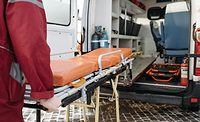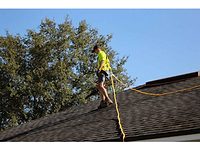Roofing Technology Trends
Study: Effectiveness of Exoskeletons in Preventing Roofing Injuries
New Zealand study shows potential benefits of roofers wearing exoskeletons for back support

It’s no secret that roofing is hard work with the potential to cause long-term physical ailments due to roofers constantly stooping, lifting heavy items and navigating ladders. But a new study shows there may be ways to alleviate physical stress and even prolong a roofer’s career with exoskeletons.
A pilot study from charitable trust Construction Health and Safety New Zealand and the Roofing Association of New Zealand shows the potential benefits of roofing workers using exoskeletons on the job to improve their overall health. The small study followed three roofers in New Zealand for two weeks, monitoring their work and rest patterns. The subjects included an older roofer (age 65) looking to extend their career; a roofer managing a pre-existing back injury (age 38); and a younger roofer getting acclimated to roofing (age 30).
For one week, the roofers worked as they normally would, while the second week they wore an Exxovantage HAPO passive back support exoskeleton. During both weeks, they wore a small personal measurement device on their chest to monitor their sleep, heart rate, stress levels, physical activity levels and other data points.
The resulting data showed the participants had varying degrees of reduced fatigue, musculoskeletal discomfort, pain and injury.
“Despite the small sample size, on average, results showed substantial physiological improvements from wearing the exoskeleton, with an average physiological score increase of 11%,” the study states.
Additionally, stress and recovery increased on average by 6%, restorative sleep by an average of 9% and health effects of physical activity by 16%. Participants even gained 39 more minutes of sleep on average.
“Objectively, physiologically, we saw some real benefits with such a small sample size,” said Dr. Kelly Dale from Healthy Lifestyle NZ in a webinar. “They’re more physically active and, critically, some improvements in sleep.”
Subjective Stances
Along with objective data, the roofers provided subjective views on the exoskeleton’s comfort, compatibility and safety. The roofers all noted the exoskeleton was beneficial for certain tasks, such as screwing off an installed metal roof, welding, two-handed tasks requiring arm extension and balance, and lifting objects. Paul Stanley-Boden of Red & Black Roofing Co. Ltd. was one of the subjects, and spoke about his experience in a webinar.
“The amazing sensation when you first bend over with it is you feel like you’re hovering over the work area, it’s totally supportive,” said Stanley-Boden. “As a result of that, zero lower back pain.”
Conversely, they said the exoskeleton hindered them with making metal sheets on the ground, flashing work, and work that required them to be in confined or restrictive areas. The roofers also noted there were some issues caused by the exoskeleton’s restrictions on their movement, and some difficulties using tool belts.
“With the exoskeleton, trying to transition from a ladder onto a flat work surface, at times you felt like the exoskeleton wanted to throw you off the scaffolding,” said Stanley-Boden.
Overall, the three roofers gave neutral to positive reviews for the exoskeleton, saying it was beneficial when roofing and could help extend a career in the industry. One of the participants suggested that, due to a higher risk of damage to the exoskeleton in residential roofing, it might be better suited for commercial roofing.
It’s been suggested another study take place during the summer months when roofers experience heavier workloads. Exxovantage, the company that provided the exoskeleton, has also developed a suit that doesn’t have an external framework, which might make it easier for a roofer to navigate without risk of catching the suit on scaffolding or the like.
Along with using equipment to address physical fatigue, the study encourages educating roofing contractors on preventing musculoskeletal disorders with ergonomics like exoskeletons. Through toolbox talks, the study suggests education can lead to healthier roofers.
“Knowledge disrupts wrong belief systems commonly held by construction workers, for instance, the need to reflect a ‘tough’ image, the belief that poor working habits will not cause them injury, or the belief that injury is inevitable wear and tear,” the study states.
Looking for a reprint of this article?
From high-res PDFs to custom plaques, order your copy today!






.jpg?height=200&t=1735294415&width=200)